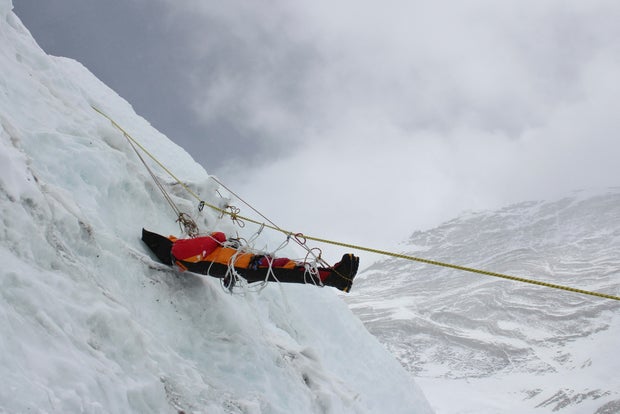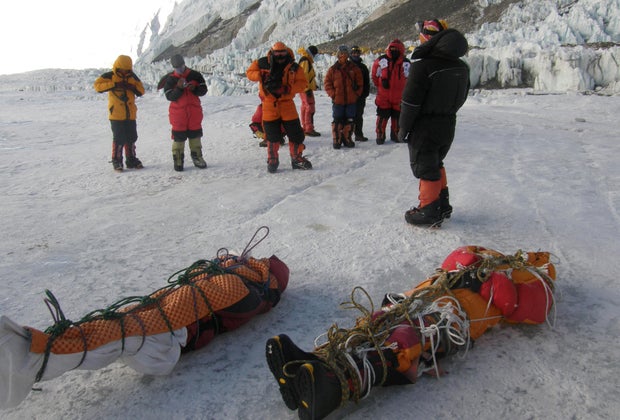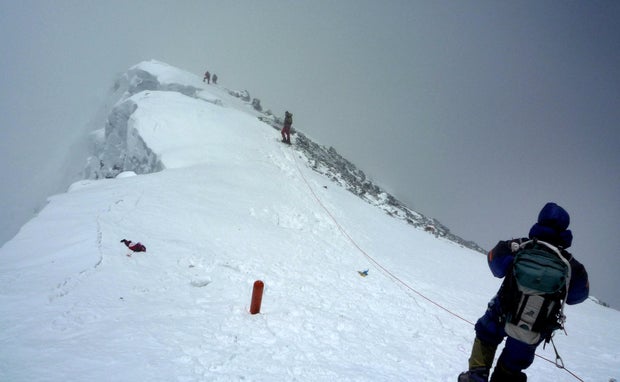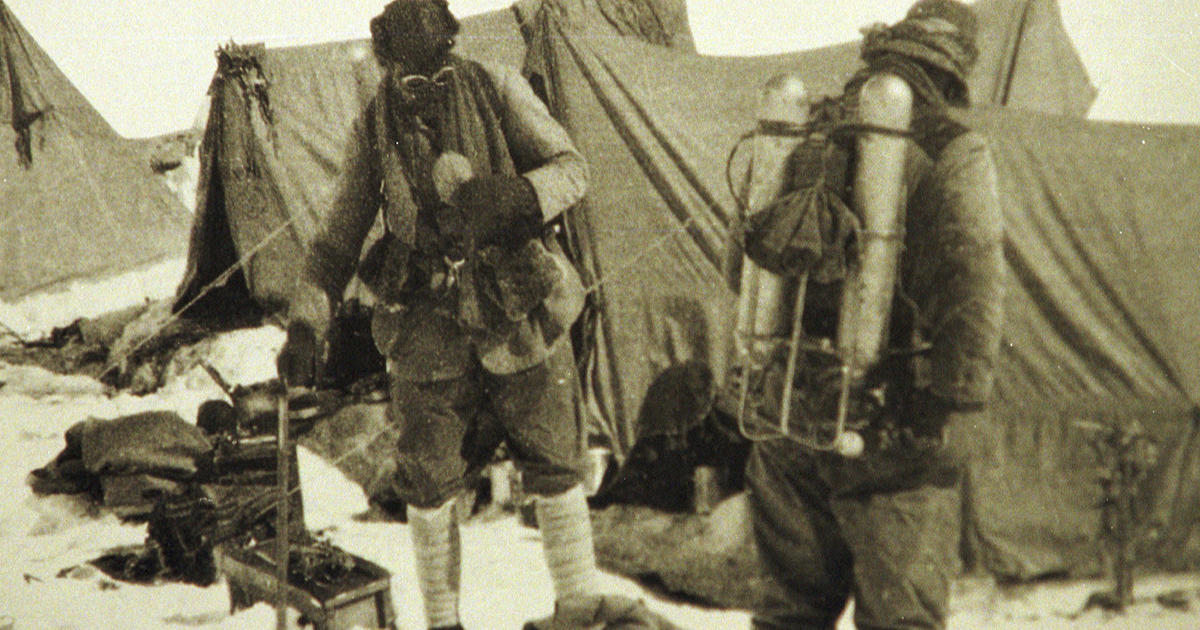CBS News
Mount Everest’s melting ice reveals bodies of climbers lost in the “death zone”

Kathmandu – On Everest’s sacred slopes, climate change is thinning snow and ice, increasingly exposing the bodies of hundreds of mountaineers who died chasing their dream to summit the world’s highest mountain. Among those scaling the soaring Himalayan mountain this year was a team not aiming for the 29,032-foot peak, but risking their own lives to bring some of the corpses down.
Five as yet unnamed frozen bodies were retrieved — including one that was just skeletal remains — as part of Nepal’s mountain clean-up campaign on Everest and adjoining peaks Lhotse and Nuptse.
It is a grim, tough and dangerous task.
Rescuers took hours to chip away the ice with axes, with the team sometimes using boiling water to release its frozen grip.
“Because of the effects of global warming, (the bodies and trash) are becoming more visible as the snow cover thins,” said Aditya Karki, a major in Nepal’s army who led the team of 12 military personnel and 18 climbers.
NAMGYAL SHERPA/AFP/Getty
More than 300 people have perished on the mountain since expeditions started in the 1920s, eight this season alone.
Many bodies remain. Some are hidden by snow or swallowed down deep crevasses.
Others, still in their colourful climbing gear, have become landmarks en route to the summit.
Nicknames include “Green Boots” and “Sleeping Beauty.”
Mount Everest body retrievals “extremely difficult,” but necessary
“There is a psychological effect,” Karki told AFP. “People believe that they are entering a divine space when they climb mountains, but if they see dead bodies on the way up, it can have a negative effect.”
Many are inside the “death zone,” where thin air and low oxygen levels raise the risk of altitude sickness.
Climbers must have insurance, but any rescue or recovery mission is fraught with danger.
One body, encased in ice up to its torso, took the climbers 11 hours to free.
The team had to use hot water to loosen it, prising it out with their axes.
“It is extremely difficult,” said Tshiring Jangbu Sherpa, who led the body retrieval expedition. “Getting the body out is one part, bringing it down is another challenge.”
NAMGYAL SHERPA/AFP/Getty
Sherpa said some of the bodies still appeared almost as they had at the moment of death — dressed in full gear, along with their crampons and harnesses.
One seemed untouched, only missing a glove.
The retrieval of corpses at high altitudes is a controversial topic for the climbing community.
It costs thousands of dollars, and up to eight rescuers are needed for each body.
A body can weigh over 220 pounds, and at high altitudes, a person’s ability to carry heavy loads is severely affected.
But Karki said the rescue effort was necessary.
“We have to bring them back as much as possible,” he said. “If we keep leaving them behind, our mountains will turn into a graveyard.”
Bodies are often wrapped in a bag then put on a plastic sled to drag down.
Sherpa said that bringing one body down from close to Lhotse’s 8,516 metre peak — the world’s fourth-highest mountain — had been among the hardest challenges so far.
AFP/COURTESY OF PEMBA DORJE SHERPA
“The body was frozen with hands and legs spread,” he said. “We had to carry it down to Camp Three as it was, and only then could it be moved to be put in a sled to be dragged.”
Rakesh Gurung, from Nepal’s tourism department, said two bodies had been preliminarily identified and authorities were awaiting “detailed tests” for the final confirmation.
The retrieved bodies are now in the capital Kathmandu, with those not identified likely to be eventually cremated.
Everest still littered with secrets — and garbage
Despite the recovery efforts, the mountain still holds its secrets.
The body of George Mallory, the British climber who went missing during a 1924 attempt on the summit, was only found in 1999.
His climbing partner, Andrew Irvine, has never been found — nor has their camera, which could provide evidence of a successful summit that would rewrite mountaineering history.
The clean-up campaign, with a budget of over $600,000, also employed 171 Nepali guides and porters to bring back about 12 tons of garbage.
Fluorescent tents, discarded climbing equipment, empty gas canisters and even human excreta litter the well-trodden route to the summit.
PRAKASH MATHEMA/AFP/Getty
“The mountains have given us mountaineers so many opportunities,” Sherpa said. “I feel that we have to give back to them, we have to remove the trash and bodies to clean the mountains.”
Today, expeditions are under pressure to remove the waste that they create, but historic trash remains.
“This year’s trash might be brought back by the mountaineers,” said Karki. “But who will bring the old ones?”
CBS News
Illegal border crossings drop to lowest monthly number since Biden took office

Watch CBS News
Be the first to know
Get browser notifications for breaking news, live events, and exclusive reporting.
CBS News
Tennessee enacts law requiring GPS tracking of violent domestic abusers, the first of its kind in U.S.

A new law took effect Monday in Tennessee that requires GPS monitoring of the most violent domestic offenders. Born from an unspeakable tragedy, the law is the first of its kind in the U.S.
On April 12, 2021, Debbie Sisco and her daughter, Marie Varsos, were shot and killed outside Nashville by Marie’s estranged husband, Shaun Varsos, who later took his own life.
Varsos broke into his mother-in-law’s house, where Marie was staying, with guns, zip ties, and battery acid ready to hunt them down.
He had been out on bail after strangling his wife and threatening her with a gun a month earlier.
Alex Youn, Marie’s brother and Debbie’s son, was devastated.
“Two people that I love dearly were just quickly ripped out of my life,” Youn said.
Varsos was considered enough of a threat that the judge could have required a GPS tracking device as a condition of his bail, but he didn’t. Youn believes his mother and sister may still be alive if the judge had required it.
“That’s a question for the judge. It’s one that infuriates me,” Youn said.
Judges can require GPS monitoring as a condition of bail, but often don’t.
Youn turned his pain and anger into a successful push for mandated GPS tracking of aggravated assault offenders in domestic violence cases. Tennessee’s new law is called the Debbie and Marie Domestic Violence Protection Act.
One in four women and one in seven men are victims of domestic violence, according to the CDC.
“When there’s firearms at play, when there’s strangulation, when there’s elevated stalking, [offenders] are more likely to do it again,” said Jennifer Waindle, a deputy director of non-profit Battered Women’s Justice Project.
That’s how GPS tracking could potentially be the difference between life and death. With the technology, victims are notified through a phone app or electronic device when an offender violates an order of protection, such as moving within a certain radius of the victim or breaching an exclusion zone, like their house. When that happens, the victim can receive multiple alerts like texts and emails, while a monitoring center calls law enforcement.
Ray Gandolf, director of business development for Tennessee AMS, is helping to lead the charge on using GPS technology as a safety tool.
“Every second matters,” Gandolf said.
Gandolf said the alerts can allow victims to look for help or find cover. “They can position themselves in a safe place, lock themselves in a place where they have the opportunity to call 911 and to get help dispatched to them immediately,” Gandolf said.
In Tennessee, Youn has made sure the names of Debbie Sisco and Marie Varsos will live on.
“I’m hopeful that other states will potentially sort of look at what Tennessee is sort of doing and take this and implement it in other states as well,” Youn said.
If you or someone you know is experiencing domestic violence, contact the National Domestic Violence Hotline by calling 1-800-799-SAFE (7233), visiting www.thehotline.org or texting “START” to 88788.
CBS News
Tennessee law mandates GPS tracking for violent domestic abusers

Watch CBS News
Be the first to know
Get browser notifications for breaking news, live events, and exclusive reporting.












